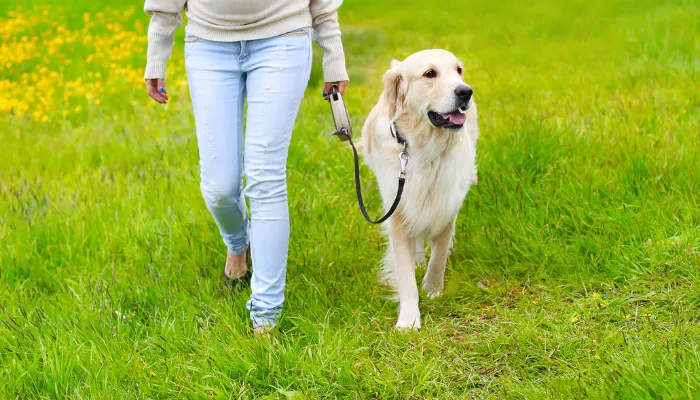There’s a special joy in seeing dogs walk calmly beside their owners at the park, seemingly unfazed by distractions. No excited barks at approaching dogs, no sudden lunges towards a group of playful children. If your puppy keeps pulling on the leash, you might feel like that serene scene is a distant dream. Many puppy owners relate to the struggle of being dragged along, desperately trying to maintain control as their energetic companion pulls with all their might.
For years, my own dog and I faced similar challenges. Walks often felt like a constant battle of strength and wills. However, through persistent research and trying various loose leash walking tips, I discovered methods that truly made a difference. This article will explore why puppies pull on the leash, effective strategies to put an end to the pulling, and the crucial role of consistency in puppy leash training. If your puppy keeps pulling on the leash, these insights will help transform your walks into enjoyable experiences.
Understanding Why Your Puppy Pulls on the Leash
Before diving into specific training methods to stop your puppy from pulling, it’s essential to understand the underlying reasons for this common behavior. Like many puppy behaviors, understanding why they pull, and how we might inadvertently encourage it, can make managing the behavior much simpler.
Simply put, puppies pull on the leash because it’s a natural canine instinct. While undesirable for us, it’s inherent to them. Pulling allows them to move forward at their own desired pace, exploring every scent and sight that captures their attention. Your puppy isn’t pulling to be dominant or defiant; they do it because it yields results. If you’re consistently pulled along by your puppy, you’re inadvertently rewarding the behavior. Each step forward while pulling reinforces the idea that pulling helps them get where they want to go. This makes breaking the habit particularly challenging if your puppy has been pulling for an extended period, as they’ve grown accustomed to moving forward while straining on the leash. A puppy’s natural reflex is often to oppose restraint, so consistency is paramount to breaking this habit. Over time, you can teach your puppy that walking calmly by your side is far more rewarding.
Not All Training Methods Work for Every Puppy
When teaching your puppy not to pull on the leash, remember that what works for one dog might not work for another. This principle applies to all aspects of dog training. Many owners, myself included, have felt like failures when a particular method didn’t yield the desired results. If you’ve tried various loose leash pulling techniques in the past without success, rest assured you are not alone.
A significant part of effective puppy training involves discovering what truly motivates your puppy and building on that. For my dog, the most successful methods involved strong incentives, primarily delicious treats and engaging toys. These motivators helped keep her focused and eager to learn during our training sessions.
You might have heard of the “be a tree” method: when your puppy starts to pull, you stop dead in your tracks and stand still. The theory is that your puppy will learn that pulling immediately halts the walk, thus discouraging the behavior. However, when I tried this with my highly excitable dog, who was already a seasoned puller, the outcome was not as expected. She simply pulled even harder, frustrated that we weren’t moving, desperate to get where she wanted to go.
While some patient owners might find success with this approach, it didn’t work effectively for us. I spent months stopping every few feet, hoping my dog would settle down. Instead, she’d often remain at the end of the leash, looking ahead, and as soon as we resumed walking, she’d be back to pulling. This method didn’t suit my dog, largely due to her high excitability and years of being rewarded for pulling. Without clear positive reinforcement, puppies often don’t understand why you’ve stopped; they might simply perceive it as a strange human quirk. This is why using treats can be far more effective, as they allow you to lure and clearly show your puppy precisely what you expect from them, rather than hoping they figure it out independently.
 A dog walking calmly on a leash in a snowy field with its owner.
A dog walking calmly on a leash in a snowy field with its owner.
Keep in mind that if your puppy keeps pulling on the leash, a single method might not be the magic bullet. Don’t get discouraged if one approach doesn’t work. The journey of training your puppy involves understanding their individual motivations and building on those to establish good leash manners.
1. Choose One Walking Method and Stick With It
The first critical step in teaching your puppy not to pull is to select a consistent walking method. Your puppy needs to learn what constitutes acceptable behavior on a walk, and establishing a clear goal for how you want them to walk—and adhering to it—is the quickest route to success.
Do you prefer your puppy to walk on your right side, left side, or perhaps a few steps behind? Make a decision and ensure that everyone who walks your puppy follows this chosen method consistently. For example, if you want your puppy to always stay on your left, ensure every family member reinforces this. Consistency helps your puppy understand exactly what is expected of them, making the training process much smoother and more effective, especially for a puppy still learning the ropes.
2. Start Training in a Non-Exciting Area
To set your puppy up for success, avoid overwhelming them with distractions during initial training sessions. When you’re teaching your puppy to walk calmly and nicely, it’s crucial to choose a low-distraction environment, not a bustling park teeming with squirrels and other excited dogs. Opt for a quiet time of day to practice walking down your street, or visit a park during off-peak hours when fewer people and animals are around.
If you take your puppy to a crowded park before they’ve developed good leash manners and proper impulse control, they’re likely to be too stimulated and excited to focus and learn. All those intriguing sounds, smells, and sights—not to mention squirrels—will be far too distracting. Don’t set your puppy up for failure. Begin by teaching your puppy how to walk nicely in a calm, controlled environment, and gradually introduce more distractions as they improve. This incremental approach will significantly help if your puppy keeps pulling on the leash.
 A dog looking expectantly at its owner while on a leash in a grassy field.
A dog looking expectantly at its owner while on a leash in a grassy field.
3. The “Cheater” Method: Using a Front-Clip Harness
My personal favorite method for addressing leash pulling, especially if My Puppy Keeps Pulling On The Leash, is what I affectionately call the “cheater method”: using a front-clip harness. These harnesses are incredibly effective and straightforward to use, though figuring out how to put them on correctly the first couple of times can be a minor challenge.
I have absolutely no regrets about switching to a front-clip harness years ago; in hindsight, it’s a tool I wish I’d discovered much earlier. I’ve rarely seen any piece of equipment have such an immediate and positive impact on walks. Using a front-clip harness is one of my top dog walking tips precisely because it offers a simple, effective way to “reset” your puppy’s leash manners, particularly if you haven’t been using one.
This method works especially well for puppies and dogs already accustomed to pulling when using a traditional collar or a back-clip harness. Instead of pulling from the back of their neck, they suddenly find themselves pulling from the front. This changes the leverage point, gently redirecting them back towards you when they pull, making it much harder for them to gain momentum. From the moment you start using the new harness, offer plenty of praise when your puppy walks nicely. Your puppy will quickly begin to associate the harness with pleasant, loose-leash walking. This approach mirrors how many police K9s are trained; they wear different collars or harnesses depending on the task, helping them mentally switch to specific behaviors.
Before I tried a front-clip harness, I had always used a traditional leash and collar, and my dog had become a consistent puller. She would start pulling as soon as we stepped out the door. The moment I switched to the front-clip harness, everything changed. She wasn’t used to the different feel or the leash clipping at the front. I capitalized on this adjustment period by actively teaching her polite walking manners, and she quickly adapted to the new equipment. Since then, our walks have become significantly more enjoyable. If your puppy keeps pulling on the leash, this simple switch can offer immediate relief and a fresh start for training.
4. The Positive Reinforcement Method: Load Up on Treats
If purchasing a new harness isn’t an option, or if you prefer a different approach, you can still effectively encourage your puppy to walk nicely on the leash by using plenty of treats. Regardless of the method you choose to stop your puppy from pulling, the most crucial element is keeping your puppy motivated. This is where treats become incredibly beneficial. To encourage good walking behavior, you need to clearly show your puppy that positive things happen when they walk calmly by your side. The easiest way to achieve this is through the use of high-value, delicious treats.
To begin teaching loose-leash manners, choose a quiet, low-distraction location for your walk and bring a generous supply of treats. You can use a treat held in your hand to guide your puppy into walking beside you in a straight line. Then, vary your direction, giving them a treat each time you change course and they follow gracefully. Over time, your puppy will learn to pay attention to your movements and anticipate where you’re going, naturally following your lead.
While this method sounds simple, it requires a lot of repetition, especially if your puppy has been pulling for a long time. Breaking a deeply ingrained habit takes consistent effort, but with enough patience and reinforcement, your puppy will learn that staying by your side is the expected and most rewarding behavior. Therefore, when you start leash training your puppy, remember to use treats (or favorite toys, if your puppy is more play-motivated) to encourage them to follow you. This positive association teaches them that walking nicely without pulling on the leash leads to good things, and eventually, they will begin to exhibit this desired behavior on their own. This gentle, rewarding approach is key if your puppy keeps pulling on the leash.
Conclusion
Successfully teaching your puppy to walk nicely on a leash can transform your daily walks from frustrating struggles into pleasant bonding experiences. We’ve explored that pulling is a natural canine behavior, often reinforced unintentionally, and that no single training method works for every puppy. The key lies in understanding your puppy’s motivations and consistently applying the right techniques.
Whether you opt for the immediate assistance of a front-clip harness or the rewarding power of treats and positive reinforcement, consistency is the bedrock of success. Starting in calm environments and gradually increasing distractions will set your puppy up for success. Remember, patience and positive reinforcement are your greatest tools. By committing to these strategies, you can effectively address the issue of “my puppy keeps pulling on the leash” and foster a more harmonious walking routine for both you and your beloved companion. Consider seeking advice from a certified professional dog trainer if you encounter persistent challenges, as they can offer personalized guidance.
